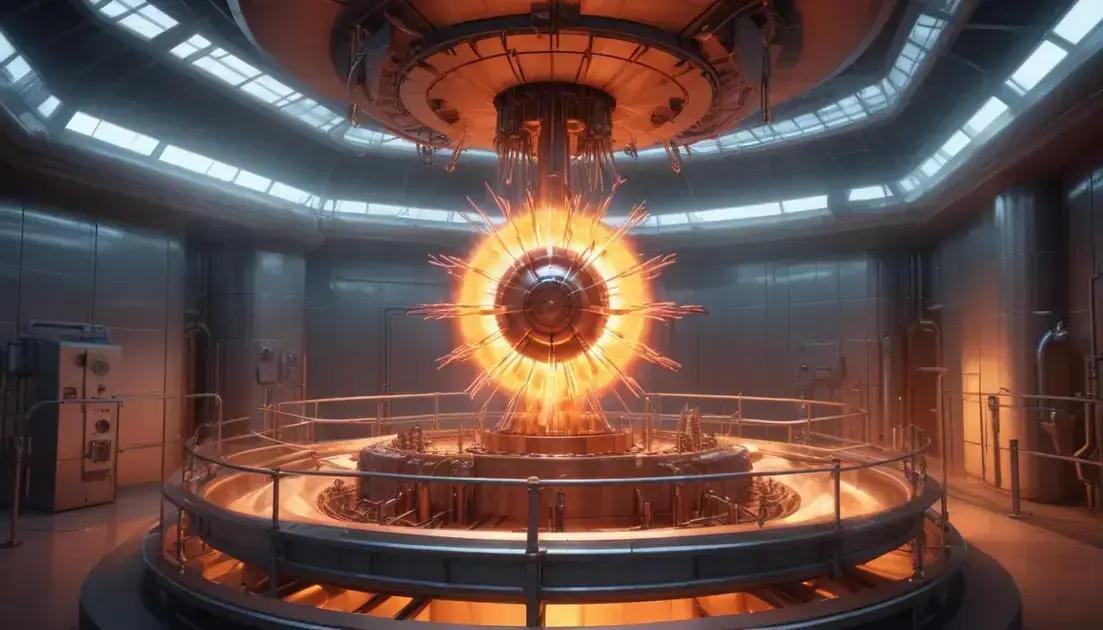
Nuclear Fusion: The Energy of the Sun in Our Hands
Nuclear fusion has the potential to revolutionize energy production by providing a clean and virtually limitless source of power. This process combines light atomic nuclei, like hydrogen isotopes, to release massive amounts of energy, mirroring the reactions that fuel the sun. Despite challenges such as achieving the high temperatures needed for fusion and managing the plasma, global collaboration on projects like ITER is advancing the technology. The future of nuclear fusion promises reduced waste and lower greenhouse gas emissions, paving the way for a more sustainable energy landscape.
Nuclear Fusion is often regarded as the energy of the future—a game changer that could reshape our approach to power generation. Imagine harnessing the same process that powers the sun to meet our energy needs!
The Basics of Nuclear Fusion
Nuclear Fusion is a process where two light atomic nuclei combine to form a heavier nucleus. This reaction releases a lot of energy, much more than fossil fuels or even nuclear fission. It’s like how the sun produces energy, which is why scientists are so excited about it!
The most common fusion reaction happens between two isotopes of hydrogen: deuterium and tritium. When these two fuse, they create helium and release energy in the form of neutrons. This energy has the potential to power our homes and cities.
One of the biggest benefits of nuclear fusion is that it produces very little waste compared to traditional energy sources. The byproducts are much easier to handle and pose less of a risk to the environment.
However, achieving fusion is not easy. It requires extremely high temperatures, similar to those found in the sun. Scientists around the world are working hard to create reactors that can maintain these conditions in a controlled way.
The advances in technology could one day make nuclear fusion a clean and virtually limitless source of energy. Imagine powering the world without harming the planet. That’s the dream scientists are aiming for!
How Nuclear Fusion Works
Nuclear Fusion is a fascinating process. It happens when two light atomic nuclei combine. This fusion creates a heavier nucleus. When this occurs, a huge amount of energy is released. This energy is what powers the stars, including our sun!
To achieve fusion, we need very high temperatures. Think about the sun’s core, which is over 15 million degrees Celsius! Scientists are trying to replicate these conditions here on Earth. They use devices called reactors to create the right environment for fusion.
One of the most common fusion reactions involves deuterium and tritium, two types of hydrogen. When they combine, they form helium and release a neutron. This process is powerful, generating energy that could be harnessed for electricity.
Scientists use magnetic fields to keep the hot plasma stable. Plasma is a state of matter made of charged particles necessary for fusion. If we can control and sustain this reaction, we can produce energy without the harmful waste of fission.
The research into how nuclear fusion works is ongoing. Many researchers believe it’s the key to a cleaner future. Imagine getting energy without pollution or greenhouse gases!
The Promise of Clean Energy
The promise of clean energy through nuclear fusion is exciting. This technology could provide a near limitless source of energy. Fusion uses fuel that is abundant and widely available. For example, it primarily uses isotopes of hydrogen, which can be extracted from water.
Unlike traditional energy sources, fusion produces very little waste. The waste that is produced is far less harmful and easier to manage. This means a cleaner environment and a sustainable energy future.
Furthermore, fusion doesn’t emit harmful greenhouse gases. That’s a big deal for fighting climate change. If we can harness the power of fusion, we could significantly reduce our carbon footprint.
The ongoing research aims to make fusion practical for everyday energy needs. Imagine powering homes, schools, and businesses without worrying about pollution. It sounds too good to be true, but scientists are making progress!
As we explore the promise of clean energy, countries around the world are investing in fusion research. This global effort shows how important clean energy is for our future.
Challenges and Future Prospects
Challenges in nuclear fusion research are significant but not impossible to overcome. One major challenge is achieving the high temperatures needed for fusion to occur. Scientists need to create conditions similar to those found in the sun, which is extremely difficult.
Another challenge is containing the hot plasma needed for fusion. Plasma is tricky to manage. It needs strong magnetic fields to keep it stable and prevent it from touching the reactor walls.
Funding is also a critical issue. Researching and developing fusion technology requires huge investments. Many countries are pooling resources to share the costs and risks involved in this exciting field.
Despite these challenges, the future prospects for nuclear fusion are bright. With ongoing research, we are getting closer to making fusion a reality. Many scientists are optimistic about when we might first achieve practical fusion energy.
Progress in technology continues to accelerate. Scientists and engineers are finding new ways to tackle the obstacles. The collaboration between nations is also fostering innovation. This teamwork is vital for turning the dream of fusion energy into a practical solution.
Global Efforts in Fusion Research
Global efforts in fusion research are growing as countries recognize the potential of this energy source. Scientists worldwide are collaborating to solve big challenges in fusion technology.
One major project is ITER, the International Thermonuclear Experimental Reactor in France. This ambitious project aims to demonstrate the feasibility of nuclear fusion as a power source. Countries like the USA, Japan, and EU members are all participating.
Research centers in several nations are developing advanced reactors. These centers are working on different techniques to achieve and maintain fusion conditions. For example, Japan’s NIF (National Ignition Facility) focuses on laser-driven fusion.
Collaboration in fusion research also includes academic institutions and private companies. Many startups are working on fusion technology, looking to accelerate progress. This mix of ideas helps drive innovation and brings fresh approaches.
Conferences and workshops allow scientists to share their findings and experiences. These events are essential for creating a shared vision of nuclear fusion’s future. As knowledge spreads, so do opportunities for breakthroughs.
Conclusion
In conclusion, the journey towards harnessing nuclear fusion as a clean energy source is filled with promise and potential. With global efforts focusing on this technology, we could reshape our energy future. The collaboration among scientists, countries, and private companies is essential for overcoming challenges.
Nuclear fusion offers many benefits, like reducing waste and lowering greenhouse gas emissions. As we continue to invest in research, we edge closer to practical and sustainable solutions for our energy needs. The vision of a cleaner, brighter future powered by fusion is within reach, and together, we can make it happen.


